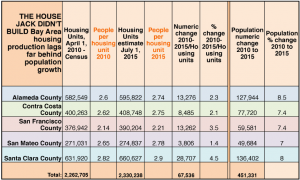By Sharon Simonson
Same as it ever was.
Even with nearly 70,000 new homes built in the Bay Area in the last five years, according to new U.S. Census Bureau data, 2015 population counts exclaim the continuing and huge disconnect between demand to live in the region and the production of new abodes.

To keep pace with population growth of more than 450,000 since 2010, the region’s five primary counties—Santa Clara, Alameda, San Francisco, Contra Costa and San Mateo—should have built 155,630 new homes, based on an average of three people per household. That’s 83,000 homes more than were produced.
The existing housing stock absorbed at least some of the difference, with the average number of people per home rising in every county. Nationally, the average number of people per housing unit is 2.4. In Santa Clara County, the average approaches 3, the highest in the region and up 3 percent from 2010 to 2015. Ironically, the number is lowest in the Bay Area’s most urban place, San Francisco: 2.21 persons per housing unit.
The growth pressure is most evident in East Bay suburbs like Dublin and Milpitas, among the fastest-growing cities in the United States, according to the new data. Dublin grew by 25 percent, nearly 12,000 new people, in the five years from 2010 to 2015. Milpitas grew 16 percent, adding nearly 11,000 new residents, and Fremont added more than 18,000 new residents.
In comparison, Palo Alto and Cupertino, at the center of Silicon Valley and within a few miles’ radius of tens of thousands of high-tech jobs, each grew less than 4 percent in the same years, adding fewer than 2,500 people each.
While some degree of growth is inevitable at the edge of urban areas where land prices are lower, the great divergence in growth rates between the Peninsula and East Bay cities is the inevitable outcome of the unwillingness of more central Bay Area places to produce more housing, said economist Christopher Thornberg. San Mateo County grew 7 percent adding nearly 50,000 new residents from 2010 to 2015. But it expanded its housing stock by 1.4 percent, or 3,806 new apartments and condos, the Census Bureau reports.
“When you throw buckets of people at a city, unless you are doing lots of rebuilding with much denser units, you have to see more growth at the periphery,” Thornberg said.
The consequences of this kind of growth are what he calls the “country club-ification” of California where cities like Palo Alto, Cupertino and Santa Monica push population and high-density housing, which is expensive for cities to serve, to other places while seeking to attract commercial uses including employers, hotels and retailers, which pay high taxes but don’t require as much city care. The result is the same kind of tax and educational disparity remarked in school districts in poorer versus richer communities, he said, except it is expressed in fewer and lesser-quality parks and other city services.
“Palo Alto is better off when San Jose is growing faster. It’s a place where all of the janitors can live, so they can work in Palo Alto,” he said. “Keeping growth out leads to bad things in other places but not for those cities. It is the tragedy of the commons: I will get mine and too bad for you.”
Developers built more than 28,700 new apartments and condos in Santa Clara County in the last five years, increasing its housing stock faster than in any other county, by 4.5 percent, to nearly 661,000 homes. But population grew 8 percent, by 136,400 people, leaving the county 17,000 homes short.![]()
Alameda County’s population grew 8.5 percent, or 128,000 people, but its housing stock grew only 2.3 percent.
Economically and environmentally, to stop the sprawl, the solution is to transform the Bay Area’s seas of single-family homes into high-rise condos, he says, a solution he acknowledges is probably politically untenable, at least for now.